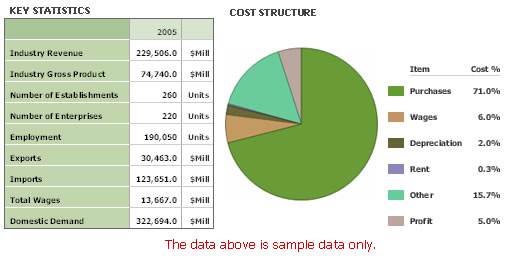Pulp Millsin USA
USA Market Research and Industry Report
8 October 2007
Industry Code : 32211
This industry comprises establishments primarily engaged in manufacturing pulp without manufacturing paper or paperboard. The pulp is made by separating the cellulose fibers from the other impurities in wood or other materials, such as used or recycled rags, linters, scrap paper, and straw. The US pulp milling industry buys raw materials such as woodchips from the woodchipping industry as well as coal, dies, chemical resins, clay mud, lime, white and black liquor etc, from various manufacturers and processes these into pulp. There are many types of pulp made, including mechanical and chemical (known as kraft). The types of market pulp sold to downstream paper, paperboard, and paper packaging manufacturers (domestic and overseas) include: NBSK - northern bleached softwood kraft; NBHK - northern bleached hardwood kraft; SBSK - southern bleached softwood kraft; SBHK - southern bleached hardwood kraft.
The major products and services in this industry are:
| - | Wood pulp |
| - | Other fiber pulp | |
The primary activities of this industry are:
| - | Separating cellulose fibers in wood, recycled paper and straw |
| - | Sulfite pulp |
| - | Special alpha and dissolving pulp |
| - | Sulfate woodpulp, bleached and semibleached, including soda |
| - | Sulfate woodpulp, unbleached |
| - | Groundwood pulp |
| - | Semichemical woodpulp |
| - | All other miscellaneous pulp, other than wood | |
IBISWorld research reports contain trend analysis, statistics, market size information, industry growth rates as well as market share of competitors.
Major market segments are identified and also those forces affecting demand and supply within the industry. Performance analysis includes emerging industry trends as well as recent results and performance of each key company. Drawing on the depth of information IBISWorld also provides 5 year forecasts for each industry.
Each comprehensive study also examines details such as the barriers to entry, operating cost structure, technology & systems and domestic & international markets. Tables and statistics include: Industry revenue, exports, imports, wages and number of companies in the industry, Industry growth and geographic regional data.
Each comprehensive study also examines details such as the barriers to entry, operating cost structure (including averages), technology & systems and domestic & international markets. Tables and statistics include: Industry revenue, exports, imports, wages and number of companies in the industry, Industry growth and geographic location.






